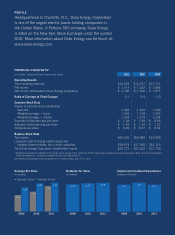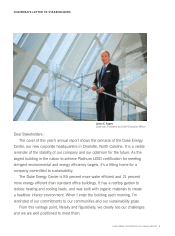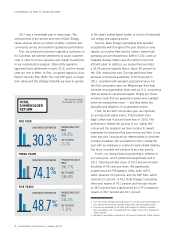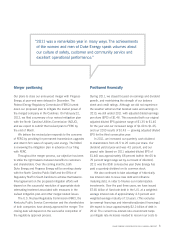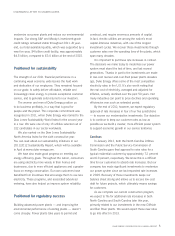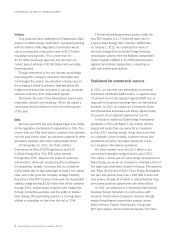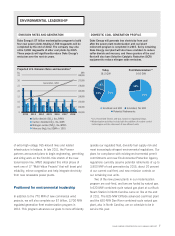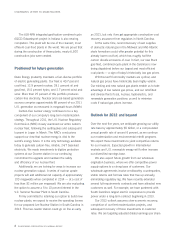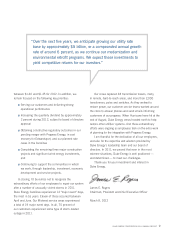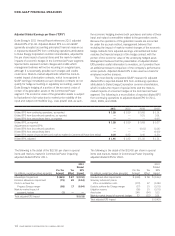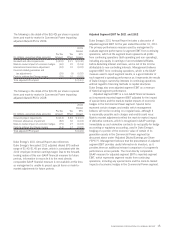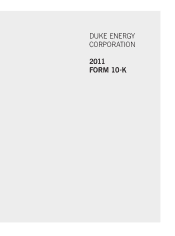Duke Energy 2011 Annual Report Download - page 10
Download and view the complete annual report
Please find page 10 of the 2011 Duke Energy annual report below. You can navigate through the pages in the report by either clicking on the pages listed below, or by using the keyword search tool below to find specific information within the annual report.
CHAIRMAN’S LETTER TO STAKEHOLDERS
The 618-MW integrated gasification combined-cycle
(IGCC) Edwardsport project in Indiana is also nearing
completion. This plant will be one of the cleanest, most
efficient coal-fired plants in the world. We are proud that
during the construction of these plants, nearly 6,500
construction jobs were created.
Positioned for future generation
Duke Energy prudently maintains a fuel-diverse portfolio
of electric generating plants. Our fleet is 40.7 percent
coal-fired, 12.9 percent nuclear, 28.1 percent oil and
gas-fired, 15.5 percent hydro, and 2.7 percent wind and
solar. More than 25 percent of this portfolio produces
carbon-free electricity. Nuclear and coal-based generation
sources comprise approximately 88 percent of our 2011
U.S. generation as measured in megawatt-hours (MWh).
Carbon-free nuclear energy continues to be a key
component of our company’s long-term modernization
strategy. Throughout 2011, the U.S. Nuclear Regulatory
Commission (NRC) closely examined our entire nation’s
nuclear fleet, following the earthquakes and subsequent
tsunami in Japan in March. The NRC’s conclusions
support our view that nuclear energy is vital to the
world’s energy future. It is the only technology available
today to generate carbon-free, reliable, 24/7 baseload
electricity. We made investments to digitize protection
systems at our Oconee station in our continuing
commitment to upgrade and maintain the safety
and efficiency of our nuclear fleet.
Additionally, we are looking for ways to increase our
nuclear generation output. A series of nuclear uprate
projects will add additional net capacity of approximately
100 megawatts when completed in 2014 — at a cost of
less than $2 million per megawatt. We are also evaluating
the option to assume a 5 to 10 percent interest in the
V.C. Summer Nuclear Plant in South Carolina.
Firmly committed to retaining our option to build new
nuclear plants, we expect to receive the operating license
for our proposed Lee Nuclear Station in South Carolina in
2013. This two-reactor station could go on line as early
as 2021, but only if we get appropriate construction cost
recovery assurance from regulators in North Carolina.
At the same time, recent discovery of vast supplies
of domestic natural gas in the Midwest and Mid-Atlantic
shale formations could offer greater potential for this
already lower-cost fuel, which has roughly half the
carbon dioxide emissions of coal. In fact, our new Buck
gas-fired, combined-cycle plant in the Carolinas is now
being dispatched before our largest and most efficient
coal plants — a sign of today’s historically low gas prices.
Will this last? Commodity markets are cyclical, and
natural gas prices have historically been highly volatile.
Our existing and new natural gas plants enable us to take
advantage of low natural gas prices, and our retrofitted
and diverse fleet of coal, nuclear, hydroelectric, and
renewable generation positions us well to minimize
costs if natural gas prices increase.
Outlook for 2012 and beyond
Over the next five years, we anticipate growing our utility
rate base by approximately $5 billion, or a compounded
annual growth rate of around 6 percent, as we continue
our modernization and environmental retrofit programs.
We expect these investments to yield competitive returns
for our investors. Expected growth in international
markets and U.S. renewable energy will further increase
our diversified earnings base.
We also expect future growth from our wholesale
origination business, where we offer competitive power
supply options to a strong base of customers. Our
wholesale agreements involve creditworthy counterparties,
stable returns and formula rates that true up annually,
eliminating regulatory lag. We have recently extended
several full-requirements contracts and have attracted new
customers as well. For example, we have partnered with
South Carolina’s largest electric cooperative to provide
power under a long-term contract beginning in 2013.
Our 2012 outlook assumes slow economic recovery,
completion of our fleet modernization projects, and
subsequent recovery of those investments in customer
rates. We are targeting adjusted diluted earnings per share
8 DUKE ENERGY CORPORATION 2011 ANNUAL REPORT


